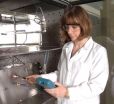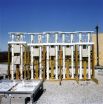(Press-News.org) Paleontologists agree that it's difficult to observe behavior in fossil specimens that are dead – even extinct – and petrified. One method is to find a modern, living, species that has some similarities to the ancient animal.
That's the strategy adopted by David L. Meyer, University of Cincinnati professor of geology and colleagues as they study a group of ancient shellfish known as brachiopods. Although they resemble clams or other shelled mollusks, brachiopods are more closely related to marine worms. Relatively rare today, brachiopods were a dominant species in Paleozoic seas.
In the fossil-rich rocks of the Cincinnati region, a group of brachiopods known as strophomenates are found fossilized surrounded by tiny "moats." It is believed that the brachiopods themselves made the moats, but it is not certain how they did so. Paleontologists think the animals needed to open their shells to a gape of more than 45 degrees to make the moats.
Meyer, along with Benjamin Dattilo of Indiana University Purdue University Fort Wayne (a Ph.D. graduate of UC's geology program), and two students went looking for a modern analogue to the Paleozoic brachiopods. They found a tiny modern brachiopod named Thecidellina meyeri in the waters off Curaçao in the southern Caribbean.
"It's a reasonably good analogue," Meyer said. "They gape widely, and the internal anatomy shows similar structures."
Meyer, Dattilo, and UC students Tanya Del Valle and Christine Rahtz collected a fragment of coral covered with more than 30 Thecidellina specimens, and placed it in a tank with running seawater in the lab in Curaçao.
"They rapidly recovered," Meyer said, "resumed normal feeding behaviors, and maintained a 90-degree gape."
With video cameras recording, the paleontologists measured the ability of the modern brachiopods to move water around, generating relatively sluggish feeding currents and relatively strong currents when they snapped their shells shut.
Sometimes, the brachiopods would snap shut, stay shut, and then slowly open. At other times, they would open partially and shut several times in rapid succession.
The behavior of the modern animals provides a clue to ancient behaviors.
"By analogy," Meyer said, "feeding currents of the ancient brachiopods were too weak to disturb sediments, allowing them to feed close to the sea floor."
### END
Paleontologists audition modern examples of ancient behavior
2011-03-18
ELSE PRESS RELEASES FROM THIS DATE:
Pardee Homes' Manzanita Trail in Coastal-close North San Diego County Offers Options for Downsizing
2011-03-18
Home shoppers who want the bigger bedroom count, but not the responsibilities of a big yard, have two great choices at Pardee Homes' Manzanita Trail in Pacific Highlands Ranch. The classic front porch designed Plan 1 and Plan 2 homes each have four bedrooms and very manageable side courtyards that help free the homeowner from yard work. Residents at Manzanita Trail also enjoy all the benefits of living within walking distance to the private Pacific Highlands Ranch Recreation Center.
Families like the McSherrys, who have four children, were thrilled to downsize from their ...
Breaking the mucus barrier unveils cancer cell secrets
2011-03-18
Washington, D.C. (March 16, 2011) -- Measuring the mechanical strength of cancer cell mucus layers provides clues about better ways to treat cancer, and also suggests why some cancer cells are more resistant to drugs than others, according to Kai-tak Wan, associate professor of engineering at Northeastern University, Boston, Mass.
According to Wan, healthy tissues naturally secrete mucus to protect against infection. Cancer cells, however, produce far more mucus than healthy cells.
Mucus consists of protein "stalks" attached to sugar sidechains, or "branches." This ...
Bacterial wipes research study
2011-03-18
(Edmonton) If you have time to quickly swipe your pager or cell phone three times, that would be your best bet to get rid of most of the bacteria. And a simple tissue moistened with saline would do the trick. But if you only have time for a single swipe of a 'dirty' phone – you'd be better off reaching for a disinfectant wipe.
Those are the highlights of a recently published research study that appeared online in PubMed, with the discoveries having been made by a team of researchers in the Faculty of Medicine & Dentistry at the University of Alberta.
"It was the mechanical ...
Fossils record ancient migrations and trilobite orgies
2011-03-18
Few specimens inspire greater thrills among fossil collectors than a complete trilobite. These ancient arthropods – relatives of lobsters, spiders and insects – went extinct more than 250 million years ago, but are sometimes found in beautifully preserved condition. In rare instances, an entire population of trilobites is found fossilized together. Carlton E. Brett finds evidence for ancient environment and behavior in these mass graves.
Brett, University of Cincinnati professor of geology, will present his findings March 20 at the Geological Society of America regional ...
New tool debuts for measuring indoor air pollutants
2011-03-18
A promising new approach for checking the accuracy of measurements of hazardous indoor air pollutants may soon be ready for prime time, report researchers from the National Institute of Standards and Technology (NIST) and Virginia Tech.* The measurement tool, a reference sample for volatile organic compounds (VOCs), would be a boon to testers of indoor air quality and to manufacturers of paints, rugs, cleaners and other building products.
The researchers put their innovation—thin squares of plastic saturated with vapors of a common solvent—through the paces at four testing ...
New NIST testing device may help to 'seal the deal' for building owners
2011-03-18
Just as a chain is as strong as its weakest link, a building is as secure against the environment as its most degraded joint sealants, about 50 percent of which fail in less than 10 years after installation.
The upshot for U.S. homeowners is that moisture damage due to failed sealants is responsible for much of the $65 billion to $80 billion they collectively shell out for house repairs annually.
Researchers at the National Institute of Standards and Technology (NIST) are assembling a toolkit of measurement devices and scientific data that will help manufacturers of ...
Study shows attendance at state parks grows, even as funding decreases
2011-03-18
A recent study from North Carolina State University shows that while the number of visits to state parks across the country has grown, fund support for park operations has been significantly reduced. The reduction in funding during a time of park growth endangers the more than $20 billion in economic impact that state parks have on the nation's economy.
"Obviously the reduction in general-fund support for operations puts stress on America's state-park systems," says Dr. Yu-Fai Leung, NC State associate professor of recreation ecology, park planning and visitor management, ...
3 in 4 domestic violence victims go unidentified in emergency rooms, Penn study shows
2011-03-18
PHILADELPHIA -- More than three quarters of domestic violence victims who report the incidents to police seek health care in emergency rooms, but most of them are never identified as being victims of abuse during their hospital visit. These findings, from a new University of Pennsylvania School of Medicine study, point to a missed opportunity to intervene and offer help to women who suffer violence at the hands of an intimate partner.
"Emergency departments are a safety net for women with health issues of all kinds, but our study shows we're not doing a good enough job ...
New findings on the developments of the earthquake disaster
2011-03-18
16.03.2011 | Potsdam: The earthquake disaster on 11 March 2011 was an event of the century not only for Japan. With a magnitude of Mw = 8.9, it was one of the strongest earthquakes ever recorded worldwide. Particularly interesting is that here, two days before, a strong foreshock with a magnitude Mw = 7.2 took place almost exactly at the breaking point of the tsunami-earthquake. The geophysicist Joachim Saul from the GFZ German Research Centre for Geosciences (Helmholtz Association) created an animation which shows the sequence of quakes since March 9.
The animated image ...
Bargain Deals for Italian and Spanish Restaurants This Month with DiscountVouchers.co.uk
2011-03-18
Eating out in the UK at top restaurant chains just became more affordable to all thanks to the latest deals from consumer voucher codes website DiscountVouchers.co.uk. The country's diners can enjoy money-saving deals this month redeemable at famous restaurants Zizzi, Ask and La Tasca.
Zizzi is one of the country's favourite Italian restaurant chains and this month DiscountVouchers.co.uk can help people enjoy eating out there without having to break the bank. Available at present on the DiscountVouchers.co.uk website is a Zizzi voucher for getting 2 main meals for only ...


